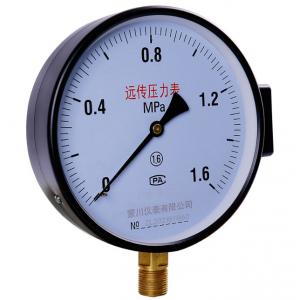Resistance Far Transmission Pressure Gauge M20*1.5 170*180*75 Remote Sensor
Add to Cart
MC YTZ150 Resistance far transmission pressure gauge 1.6 -40-60 ℃ M20*1.5 170*180*75 Remote sensor pressure gaug
Introduction
Pressure gauge refers to an instrument that uses elastic components as sensitive components to measure and indicate pressure higher than the ambient pressure. It is extremely common in applications. It covers almost all industrial processes and scientific research fields. It can be seen everywhere in the fields of heating pipe network, oil and gas transmission, water and gas supply system, vehicle repair and maintenance factories and stores. Especially in the process of industrial process control and technical measurement, because the elastic sensitive element of the mechanical pressure gauge has the characteristics of high mechanical strength and convenient production, the mechanical pressure gauge is more and more widely used.
| YTZ150 | |
| 170*180*75 | |
1.6 | |
M20*1.5 | |
| MC | |
| 0-60MPA | |
| -40-60 | |
| OEM, ODM |
Working principle
The pressure gauge uses the elastic deformation of the sensitive elements (Bourdon tube, bellows, bellows) in the watch, and then the pressure deformation is transmitted to the pointer by the conversion mechanism of the movement in the watch, causing the pointer to rotate to display the pressure.
Main structure
Overflow hole: In the event of an emergency that the Bourdon tube
bursts, the internal pressure will be released to the outside
through the overflow hole to prevent the glass panel from bursting.
Note: In order to maintain the normal performance of the overflow
hole, a space of at least 10mm must be left behind the table, and
the overflow hole cannot be modified or plugged.
Pointer: In addition to standard pointers, other pointers are also
optional.
Glass panel: In addition to standard glass, other special material
glass, such as tempered glass, and non-reflective glass are also
optional.
Performance classification: ordinary type (standard), ordinary type
for steam (M), heat resistant type (H), vibration resistant type
(V), vibration resistant type for steam (MV) heat resistant and
vibration resistant type (HV).
Treatment method: oil-free/water-free treatment to remove the water
or oil remaining in the wetted part during manufacturing.
Exterior designation: The shell color must be specified in addition
to the standard color.
Throttle valve: In order to reduce the pulsating pressure, the
throttle valve is installed at the pressure inlet.
Use attention
1. The meter must be vertical: a 17mm wrench should be used for
tightening during installation, and the case should not be forcibly
twisted; collisions should be avoided during transportation;
2. The temperature of the surrounding environment should be
-25~55℃;
3. The vibration frequency of the working environment is less than
25HZ, and the amplitude is not more than 1mm;
4. Due to the high ambient temperature during use, the indicating
value of the instrument does not return to zero or the indicating
value is out of tolerance, you can cut the sealing rubber plug on
the upper part of the case to make the inner cavity of the
instrument communicate with the atmosphere;
5. The use range of the instrument should be between 1/3 and 2/3 of
the upper limit;
6. Isolation devices should be added when measuring corrosive
media, media that may crystallize, and media with high viscosity;
7. The meter should be checked frequently (at least once every
three months), and if any malfunction is found, it should be
repaired in time;
8. If the instrument is found to be invalid or damaged due to poor
manufacturing quality under normal storage and use conditions
within half a year from the date of leaving the factory, the
company will be responsible for repair or replacement;
9. An instrument for measuring corrosive media is required, and the
required conditions should be indicated when ordering.
Pressure gauges in the national standard "General Pressure Gauges"
GB/T1226-2001 No. 4.1.2 gauges are classified according to threaded
joints and installation methods: direct mounting pressure gauges,
embedded mounting (panel mounting) pressure gauges, convex mounting
(wall mounting) pressure surface.
10 .The installation position of the pressure gauge should meet the
requirements of the installation state, the dial should not be
placed horizontally, and the height of the installation position
should be convenient for the staff to observe.
11. The distance between the installation location of the pressure
gauge and the pressure measuring point should be as short as
possible to ensure a good seal and no leakage.
12. There should be a buffer at the front end of the installed
pressure gauge; in order to facilitate inspection, a shut-off valve
should be installed under the instrument; when the medium is dirty
or there is pulse pressure, filters, buffers and stabilized gas can
be used




